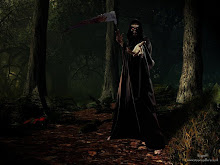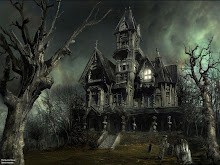In folklore and children's street culture, "Bloody Mary" is a game in which a ghost of the same name (or sometimes other names, such as "Mary Worth") is said to appear in a mirror when summoned. One of the more common ways participants attempt to make her appear is to stand before a mirror in the dark (most commonly in a bathroom) and repeat her name three times, though there are many variations. Some include chanting a hundred times, chanting at midnight, spinning around, rubbing one's eyes, running the water, or chanting her name thirteen times with a lit candle. In some versions of the legend, the summoner must say, "Bloody Mary, I killed your son!" or "I killed your baby." In these variants, Bloody Mary is often believed to be the spirit of a mother (often a widow) who murdered her children, or a young mother whose baby was stolen from her, which made her go mad in grief and she eventually commit ted suicide. In stories where Mary is supposed to have been wrongly accused of killing her children, the querent might say "I believe in Mary Worth." This is similar to another game involving the summoning of the Bell Witch in a mirror at midnight. The game is often a test of courage, as it is said that if Bloody Mary is summoned, she would proceed to kill the summoner in an extremely violent way, such as ripping his or her face off, scratching his or her eyes out, driving the person insane or bringing the person into the mirror with her. Some versions say that if you chant her name thirteen times at midnight into a mirror she will appear and you can talk to a deceased person until 12:01, when Bloody Mary and the dead person you asked to speak to will vanish. Other variations say that the querent must not look directly at her, but at her image in the mirror; she will then reveal the querent's future, particularly concerning marriage and children.
ted suicide. In stories where Mary is supposed to have been wrongly accused of killing her children, the querent might say "I believe in Mary Worth." This is similar to another game involving the summoning of the Bell Witch in a mirror at midnight. The game is often a test of courage, as it is said that if Bloody Mary is summoned, she would proceed to kill the summoner in an extremely violent way, such as ripping his or her face off, scratching his or her eyes out, driving the person insane or bringing the person into the mirror with her. Some versions say that if you chant her name thirteen times at midnight into a mirror she will appear and you can talk to a deceased person until 12:01, when Bloody Mary and the dead person you asked to speak to will vanish. Other variations say that the querent must not look directly at her, but at her image in the mirror; she will then reveal the querent's future, particularly concerning marriage and children.
Divination rituals such as the one depicted on this early 20th century Halloween greeting card, where a woman stares into a mirr or in a darkened room to catch a glimpse of the face of her future husband, while a witch lurks in the shadows, may be one origin of the Bloody Mary legend.
or in a darkened room to catch a glimpse of the face of her future husband, while a witch lurks in the shadows, may be one origin of the Bloody Mary legend.
Bloody Mary Worth is typically described as a child-murderer who lived in the local city where the legend has taken root years ago. There is often a specific local graveyard or tombstone that becomes attached to the legend.
On the other hand, various people have surmised that the lore about taunting Bloody Mary about her baby may relate her tenuously to folklore about Queen Mary I, known in history by the sobriquet "Bloody Mary". The queen's life was marked by a number of miscarriages or false pregnancies. Had Mary I successfully borne a child, this would have established a Roman Catholic succession in the English monarchy and episcopacy and threatened the continuance of her religious persecutions after her death. Speculation exists that the miscarriages were deliberately induced. As a result, some retellings of the tale make Bloody Mary the queen driven to madness by the loss of her children. It is likely, however, that Queen Mary I provided only her nickname to the Bloody Mary of folklore. She is also confused in some tellings of the story with Mary Queen of Scots.
The mirror ritual by which Bloody Mary is summoned may also relate to a form of divination involving mirrors and darkness that was once performed on Halloween. While as with any sort of folklore the details may vary, this particular tale encouraged young women to walk up a flight of stairs backwards, holding a candle and a hand mirror, in a darkened house. As they gazed into the mirror, they were supposed to be able to catch a view of their future husband's face. There was, however, a chance that they would see the skull-face of the Grim Reaper instead; this meant, of course, that they were destined to die before they married.
Divination rituals such as the one depicted on this early 20th century Halloween greeting card, where a woman stares into a mirr
Bloody Mary Worth is typically described as a child-murderer who lived in the local city where the legend has taken root years ago. There is often a specific local graveyard or tombstone that becomes attached to the legend.
On the other hand, various people have surmised that the lore about taunting Bloody Mary about her baby may relate her tenuously to folklore about Queen Mary I, known in history by the sobriquet "Bloody Mary". The queen's life was marked by a number of miscarriages or false pregnancies. Had Mary I successfully borne a child, this would have established a Roman Catholic succession in the English monarchy and episcopacy and threatened the continuance of her religious persecutions after her death. Speculation exists that the miscarriages were deliberately induced. As a result, some retellings of the tale make Bloody Mary the queen driven to madness by the loss of her children. It is likely, however, that Queen Mary I provided only her nickname to the Bloody Mary of folklore. She is also confused in some tellings of the story with Mary Queen of Scots.
The mirror ritual by which Bloody Mary is summoned may also relate to a form of divination involving mirrors and darkness that was once performed on Halloween. While as with any sort of folklore the details may vary, this particular tale encouraged young women to walk up a flight of stairs backwards, holding a candle and a hand mirror, in a darkened house. As they gazed into the mirror, they were supposed to be able to catch a view of their future husband's face. There was, however, a chance that they would see the skull-face of the Grim Reaper instead; this meant, of course, that they were destined to die before they married.















































































